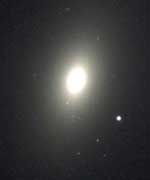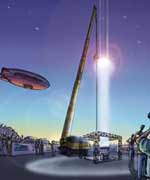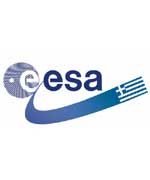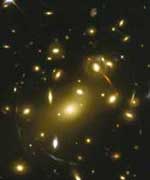
Image credit: NOAO/AURA/NSF
Monday, March 28 – This date is a very important one for Heinrich W. Olbers. It was on this night in 1802 that he discovered his second asteroid – Pallas – while observing Ceres (discovered 15 months earlier). Only five years later in 1807, Olbers discovered Vesta on this same night making it the fourth to be found.
Race ahead of the Moon tonight and head out early to view asteroid Pallas using just binoculars. At around magnitude 7, Pallas can be found tonight west of Epsilon Virginis, but telescope users are in for an exclusive treat! Using low power, locate M59 and M60 – asteroid Pallas will be in the same field of view for most observers just north of M59 and will be far brighter than any nearby star. Both the M59 and M60 are two of the most massive ellipticals in the Virgo cluster and both are roughly 60 million light years distant. Sharp-eyed observers with larger scopes will also see spiral galaxy NGC 4647 in the same lower power field, making this observation even better.
Wishing you clear skies for this event…
Tuesday, March 29 – For Southern Hemisphere viewers, try your hand at detecting Comet C/2005 A1 LINEAR while it passes near Zeta Phoenix on this universal date.
Tonight let’s use the later rise of the Moon to our advantage and head about 2 degrees northeast of star 13 in Monoceros. Our study will be NGC 2261 – more commonly known as “Hubble’s Variable Nebula”. Named for Edwin Hubble, this 10th magnitude object is not only very blue in appearance to larger apertures, but is a true enigma. Fuelling star, variable R Monoceros does not display normal stellar spectrum and may be a protoplanetary system. R is usually lost in the high surface brightness of the “comet-like” structure of the nebula, yet the nebula itself varies with no predictable timetable – perhaps due to dark masses shadowing the star. We do not even know how far away it is, because there is no detectable parallax!
Wednesday, March 30 – For observers in Hawaii, this will be your opportunity to watch the Moon occult Sigma Scorpii and Antares on this universal date. Please check this IOTA webpage for times in your area.
Our large binocular and telescope study for this evening is located roughly halfway between Sirius and Alpha Monoceros – NGC 2359. Known as “Thor’s Helmut”, this bubble-like emission nebula was blown into existence by a super-heated blue giant star in its center. The NGC 2359 spans about 30 light years and is about 15,000 light years away. The fuelling Wolf-Rayet star produces high speed stellar winds which may have interacted with a nearby molecular cloud, giving this strange nebula its curved shape. At magnitude 11, “Thor’s Helmut” is an unusual observation to add to your collection.
Thursday, March 31 – Did you miss your chance at Pallas? Then head back out tonight with the telescope as the moving asteroid will now be approximately one half degree east/southeast of the M90 for most observers. The M90’s outer arms no longer contain star-forming regions, but it’s one of the largest spiral galaxies in the Virgo cluster. Moving toward us, it is possible this galaxy has already escaped the cluster’s influence. (For those observing with large telescopes, magnify and see if you can catch 14th magnitude companion IC 3583.) Using low power, enjoy this wonderful 10th magnitude spiral galaxy and the bright “traveller” in the same field.
For a real challenge, try spotting IC 2118 about a thumb’s width west of Beta Orionis before it sets. “The Witch Head Nebula” is a huge area of reflection illuminated by Rigel, but is very faint. With excellent conditions you may be able to spot some patches of nebulosity.
Be sure to watch for any meteors which may be associated with the Eta Draconid meteor shower. These infrequent fliers can be attributed to Comet Abell (1954 X) and are still being studied.
Friday, April 1 – Today in 1960 the first weather satellite – Tiros 1 – was launched. If weather provides you with clear skies this evening, let’s work on a study that is within both binocular and telescopic ability. Turn left at Betelgeuse and you will find open cluster NGC 2244 about 2 degrees east of Epsilon Monoceros.
Containing around two dozen resolvable stars, a good, dark night will treat binocular and low power telescope users to the NGC 2237 – “Rosette” nebula. Surrounding this pretty open cluster like a faint, misty wreath – the “Rosette” may be one of the most massive nebulae known. It is possible that the star cluster may have used all the “raw material” in formation, leaving the center clear… And it is equally probable that the intense radiation of these hot, young blue stars simply blew away the gas. Either way, this pair will become an annual favourite.
If you see a “shooting star” tonight, it could be one of the Tau Draconids!
Saturday, April 2 – Today in 1845, the first photograph of the Sun was taken. While solar photography and observing is the domain of properly filtered telescopes, no special equipment is necessary to see some effects of the Sun – only the correct conditions. Right now Earth’s magnetosphere and magnetopause (the point of contact) are positioned correctly to interact with the Sun’s influencing interplanetary magnetic field (IMF) – and the plasma stream which flows past us as solar winds. During the time around equinox, this leaves the door wide open for one of the most awesome signs of Spring – aurora! Visit the Geophysical Institute to sign up for aurora alerts and use their tools to help locate the position of the Earth’s auroral oval.
Sunday, April 3 – Tonight Jupiter will be at opposition – meaning its celestial longitude is 180 degrees from the Sun and will be visible all night long. You will be able to watch the transit of Europa’s shadow between 16:30 and 19:11 UT, and Io’s shadow from 23:23 until 01:35 UT on April 4. Also viewable will be the “Great Red Spot” which will make its appearance at 04:23 and 14:19 and for viewers further west, 00:15 UT on April 4.
While out observing, be on the lookout for the Kappa Serpentid meteor shower, whose radiant is near Corona Borealis. The fall rate will be about 5 per hour.
Until next week? Ask for the Moon, but keep reaching for the stars! Light speed… ~Tammy Plotner



